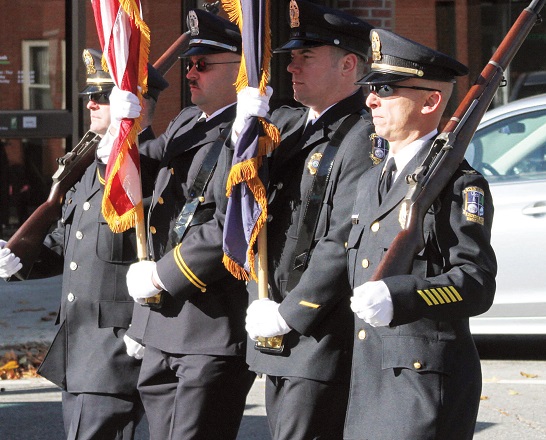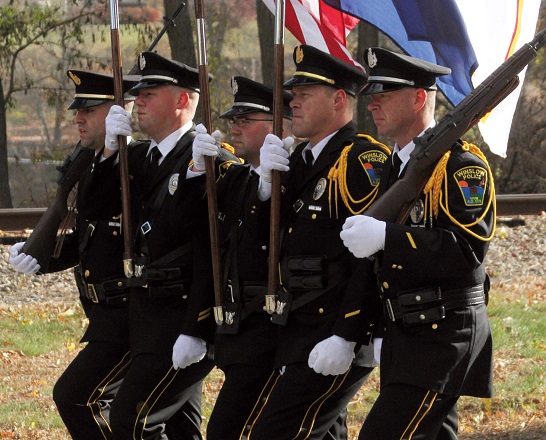China: Selectmen deal with local issues; Farrington chosen chairman
by Mary Grow
At their Nov. 14 meeting, China selectmen dealt with results of the Nov. 8 local election and with a petition organized by Neck Road resident Marie Michaud and others.
Neil Farrington was elected the new chairman of the Board of Selectmen; Irene Belanger was re-elected secretary. To applause from the audience, Farrington presented a certificate of appreciation to previous chairman Robert MacFarland, who was not re-elected Nov. 8.
Voters on Nov. 8 approved five local referendum questions that require action by selectmen, to wit:
- Appropriating $12,000 from the town surplus account to buy a parcel of land adjoining the town office lot.
- Authorizing acceptance of a piece of land on the east side of Lakeview Drive opposite the former Candlewood Camps as a gift from Wachusetts Properties, Inc.
- Appropriating up to $3,800 from surplus for a community needs assessment focused on older residents’ needs.
- Authorizing selectmen to give the recently acquired former portable classroom to the South China Library for $1 plus moving costs, with library officials to have 60 days to decide whether to take the building.
- Appropriating up to $10,000 from the Development Program Fund to buy land at the head of China Lake’s east basin for improved parking for the boat landing. The Development Program Fund gets its money through the Tax Increment Financing (TIF) Program funded by taxes paid on the expanded Central Maine Power Company line through China.
Selectmen voted unanimously to direct Town Manager Daniel L’Heureux to start implementing the decisions.
They made a decision of their own: beginning Monday, Dec. 12, the China transfer station will be open Mondays, Tuesdays, Fridays and Saturdays (except on holidays), instead of Mondays, Wednesdays, Fridays and Saturdays. One of the two ordinances whose amendments voters rejected Nov. 8 would have made the same change; selectmen decided they have authority to do it.
Resident Sandra Kostron complimented transfer station staff for being helpful and for keeping the facility neat.
The petition, which Michaud said had 364 signatures, asked selectmen to declare a six-month moratorium on new commercial development to give time to reconstitute the Comprehensive Plan Implementation Committee “in order to establish Land Use Districts in accordance with the goals and provisions set forth and prescribed by the China Comprehensive Plan,” adopted in 2008.
The petition is a result of Parris and Catherine Varney’s still-unresolved application to use their barn on Neck Road for weddings and similar functions. Neighbors argue noise, traffic, lights and other features are inappropriate in a residential neighborhood; planning board members hearing the application said the town ordinance lacks the specificity – for example, decibel limits for noise – they need to make decisions.
Selectmen, L’Heureux and audience members talked about legal requirements for a moratorium, the history of the Comprehensive Plan Implementation Committee that has been inactive for several years and the difficulty of creating districts in a town where uses intermingle and where voters have traditionally opposed zoning.
Selectmen voted 4-1, with new board member Jeff LaVerdiere opposed, to revive the Implementation Committee for the specific purpose stated in the petition. Board members asked L’Heureux to see how many former members still want to serve; Michaud had a list of potential committee members. The manager proposed limiting the committee to 15 members.
Selectmen did not impose a development moratorium.
In other business Nov. 14:
- Selectmen unanimously appointed Fred Montgomery alternate member of the planning board. The alternate member, chosen from anywhere in town, may participate in board discussions but votes only when one of the five regular members in absent.
- James Wilkens volunteered to join the Tax Increment Financing (TIF) Committee and was immediately appointed. The next committee meeting is scheduled for 6:30 p.m. Monday, Nov. 21.
- Selectmen disagreed over whether they should appoint a committee to work on senior citizens’ issues this month or after they see results of the survey voters authorized. They tentatively decided to appoint committee members at their Nov. 28 meeting. Interested residents should contact the town office.
Selectmen scheduled their annual visioning session, when they discuss broad objectives and general plans for the coming year, for 6 p.m., Tuesday, Nov. 29, in the town office meeting room. The session is open to the public.






